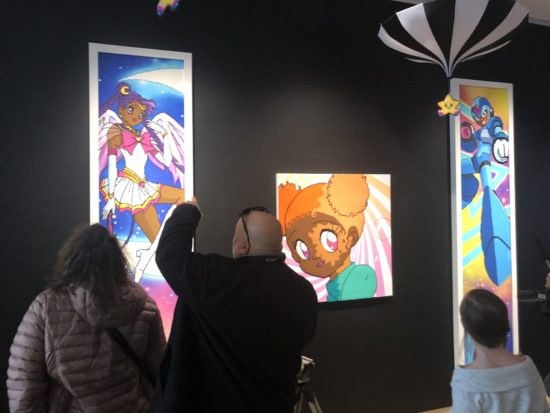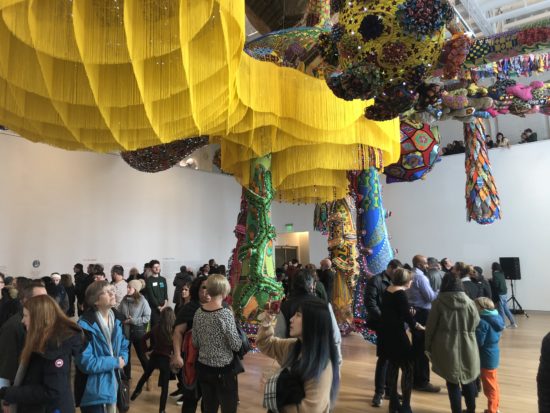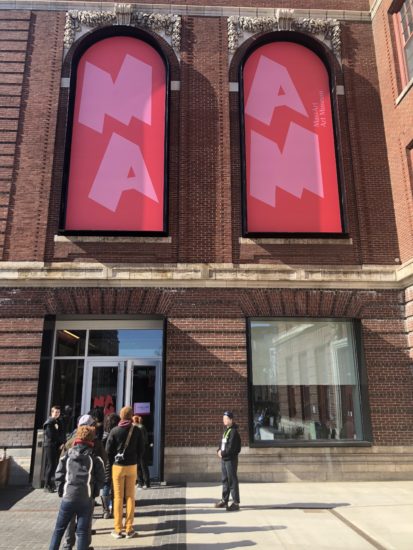This week’s contributing blogger, Nate Caldwell, is a Northeastern University senior studying Communications and Media Production.
VoCA is pleased to present this blog post in conjunction with Associate Professor of Contemporary Art History, Gloria Sutton’s Spring 2020 Honors Seminar, The Art of Visual Intelligence at Northeastern University. This interdisciplinary course combines the powers of observation (formal description, visual data) with techniques of interpretation to sharpen perceptual awareness allowing students to develop compelling analysis of visual phenomena.
In February 2020, the long-awaited opening of the MassArt Art Museum (MAAM)—Boston’s newest and only free contemporary art museum—attracted large crowds of all ages who gathered to experience not only the launch of three new exhibitions, but a renewed sense of mission to rethink the mandate of contemporary art museums. Part of the first publicly funded freestanding visual arts college in the US, MAAM is a teaching museum and operates as a Kunsthalle, a non-collecting museum which focuses on presenting a range of exhibitions.
Just after the ribbon cutting on MAAM’s opening day, a long line snaked out the front door. Once inside, the crowd buzzed as they moved their way through the lobby, itself an installation entitled Yesterday is Here by duo Ghost of a Dream. After observing the multicolored patchwork prints climbing up the walls towards the upper gallery, most made their way into Game Changers: Video Games & Contemporary Art. Spread across two large rooms, the dimly lit exhibit was accented by the pops of color emanating from the oversized screens and bright multimedia works that adorned the walls. One of the exhibition’s key artists, Momo Pixel, was standing by her works fielding questions from reporters and snapping selfies with college students. There were several interactive installations throughout the gallery, including VR headsets and video game controllers that encouraged users to interact and explore the installations which explores how video games put you in the shoes of others. Besides being united by the theme of video games, the works felt somewhat disjointed, and there wasn’t much flow or direction to the exhibit. Most visitors bounced around to whatever VR headset or controller they could get their hands on, stopping to examine other works on the walls in between the immersive experiences. Now in the age of social distancing and closures due to COVID-19, the exhibition’s emphasis on remote viewing takes on a new resonance and feels more relevant to the way people are experiencing art. In this way, Game Changers highlights the museum’s goal of expanding the reach of contemporary art, as this art can be enjoyed not just by communities here in Boston, but around the world.

Museum visitors walk through the exhibition entitled “Game Changers: Video Games & Contemporary Art”. Photo by the author.
The initial run of exhibits at MAAM also explore under-represented narratives through creative mediums, using scale and interaction to help put the viewer in unexpected roles. One such example is Joana Vasconcelos’s Valkyrie Mumbet, a tribute to Elizabeth “Mumbet” Freeman, whose court battle for her own emancipation helped make slavery illegal in Massachusetts. The installation covers the entirety of the upper gallery and dangles from the 37-foot ceilings all the way to the floor. Hanging from the ceiling is a two-story web of kente cloth and other West African fabrics, all flowing down into bulbous, organic looking shapes. Tassels and pom-poms help define the contours of the piece. From afar, the piece takes on the look of a natural organism from an alternate reality, but the detailed craftsmanship is visible on closer inspection. The crowd wove freely between the dangling bulbs, and moved up to the balcony to get a closer look at the upper extremities. Valkyrie Mumbet showed a very creative use of space, as the balcony became a tool to let viewers examine parts of the work that would be inaccessible in other galleries. Despite the severity of Freeman’s life, the work has an almost playful feel, which could represent the exuberance and joys of freedom after a life of oppression.

A crowd stands below Joana Vasconcelos’s Valkyrie Mumbet, a tribute to Elizabeth “Mumbet”
Freeman, at the opening of MAAM in February 2020.
A notable aspect of MAAM is its location just steps away from the Museum of Fine Arts and the Isabella Stewart Gardner Museum, two of Boston’s oldest and most prestigious museums. So what can a new museum bring to an area that is arguably one of Boston’s best for art? For one, MAAM brings the neighborhood a much-needed focus on contemporary art. The Gardner has a single small gallery focused on contemporary art, and the MFA has a contemporary art wing, but neither is an institution dedicated to contemporary art. I reached out to MAAM Director Lisa Tung, who noted that the museum’s proximity to each other provided opportunities for visitors: “MAAM, MFA, and the Gardner comprise an art nexus. I am hopeful that tourists and visitors can see varied (historic, blue-chip, mid-career, emerging) contemporary art offerings in this corner of the Fenway Cultural District.” It is yet to be seen if tourists will head up the block to MAAM after the MFA or Gardner, but it is good to have diverse options for both those who live in the area, or tourists who might be making a Boston art trip.
With all museums now shuttered into the summer, museums have to expand beyond their walls to reach audiences—something that is core to MAAM’s mission. As Tung elaborated, “MAAM’s mission and programs support MassArt faculty and curriculum, we teach our students about contemporary art, and we prepare and train student and alumni workers for careers in the museum field.” Time will tell whether or not the community will benefit from the museum’s educational programming, but a museum with a focus on students could lead to interesting exhibits not found elsewhere in the city, breathing some new life into a sometimes rigid art scene. By making the museum free, and standing by the idea that it should be a teaching museum, MAAM is poised to make major strides for art accessibility not only in Boston but beyond as Tung and her team contend with how to carry MAAMs mission online and through remote viewing possibilities pointed to in Game Changers.

